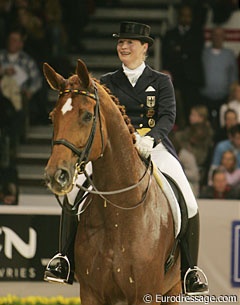
It was her error free ride that earned Isabell Werth the victory in the Grand Prix at the 2008 World Cup Finals in 's Hertogenbosch, The Netherlands, Thursday evening March 27, 2008. In their first head to head duel since the 2007 European Dressage Championships in Turin
, Italy, Isabell Werth and Anky van Grunsven proved to be very worthy and equal competitors. Anky van Grunsven placed second with a minimal point difference of 0.333%, but small imperfections in the Dutch diva's ride fairly drove her score down compared to a fault free Isabell Werth.
Dutch written press releases tried to vindicate Anky's second place by pointing at the fact that Anky was placed first with three out of five judges (including the Dutch judge Jan Peeters) and by claiming that judge at C Mary Seefried overscored Isabell by putting her 3% up front, but these poor defenses could not outweigh the quality ride Isabell had produced in the Brabanthallen in 's Hertogenbosch and the few mistakes Anky personally acknowledged that had set her back.
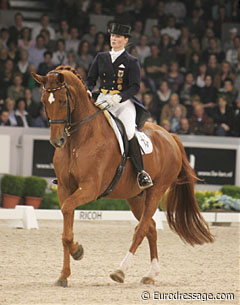 Isabell Werth entered the ring in her usual style, in free walk, then she picked up the reins and did a posting trot before she set him ready for the collected work. The German commenced her test with much power and maintained that level of brilliance throughout her ride. The chestnut Hanoverian was internally spooky in the trot tour, but Isabell rode magnificent extensions and half passes. The first piaffe-passage tour was good in rhythm, but in the piaffe the gigantic Warum Nicht almost stepped on his own hind hooves losing clarity in the movement. The extended walk was sublime with three hooves overtrack.
Isabell Werth entered the ring in her usual style, in free walk, then she picked up the reins and did a posting trot before she set him ready for the collected work. The German commenced her test with much power and maintained that level of brilliance throughout her ride. The chestnut Hanoverian was internally spooky in the trot tour, but Isabell rode magnificent extensions and half passes. The first piaffe-passage tour was good in rhythm, but in the piaffe the gigantic Warum Nicht almost stepped on his own hind hooves losing clarity in the movement. The extended walk was sublime with three hooves overtrack.
The second piaffe-passage tour was absolutely superior: superb rhythm with good spring off the ground. The one tempi changes could have covered more ground, but the pirouettes were textbook. There was no immobile halt, which unfortunately seems to be the trend at top level dressage. The ride was absolutely fault free revealing potential to score even higher in the future. The panel of judges scored the ride 75.083% which made her win the World Cup Grand Prix. Isabell Werth gave a clear message that even with her second Grand Prix horse she is a good rival to Olympic champion Anky van Grunsven.
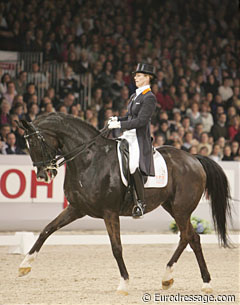 Anky Van Grunsven also had an outstanding ride. She is not the World and double Olympic champion for no reason. Her Hanoverian gelding Salinero continues to improve and looks more solid and confident in his work than ever. He is well muscled and the position of his head has ameliorated, now staying better at the vertical. The dark bay gelding is extremely expressive in the trot and entered the ring with much pizzazz. The halt was immobile until he decided to kick out his front leg once. In the first extended trot there was a loss of engagement on the diagonal after X, the second one was better. The half passes were superb. The first and second piaffe-passage were excellent, the passage now being a true passage instead of a piaffe going forwards. However, Salinero's core weaknesses are still there. The extended walk is just ok (the rhythm could be more clear and outspoken) and in the canter he's croupe high. In the first transition to canter from passage he kicked out his left hind leg high and the first flying changes in the two-tempi's was croupe high. The one tempi's were good and straight. Salinero fell into trot right before the extended canter, but Anky responded quickly and had her horse going again in a split second. Both pirouettes were outstanding, which is an improvement to previous performances and the final piaffe-passage on the center line was brilliant as well, but of course it was ended with a piaffe-non-halt. All these small mistakes cost Anky the trophy (74.750% - 2nd place), but as the Grand Prix is only a warm up class for the Kur to Music final on Saturday, nothing is lost yet. Anky is known to be the Queen of the Kur and she surely will be up for a new fight, but the same can be said of Isabell.
Anky Van Grunsven also had an outstanding ride. She is not the World and double Olympic champion for no reason. Her Hanoverian gelding Salinero continues to improve and looks more solid and confident in his work than ever. He is well muscled and the position of his head has ameliorated, now staying better at the vertical. The dark bay gelding is extremely expressive in the trot and entered the ring with much pizzazz. The halt was immobile until he decided to kick out his front leg once. In the first extended trot there was a loss of engagement on the diagonal after X, the second one was better. The half passes were superb. The first and second piaffe-passage were excellent, the passage now being a true passage instead of a piaffe going forwards. However, Salinero's core weaknesses are still there. The extended walk is just ok (the rhythm could be more clear and outspoken) and in the canter he's croupe high. In the first transition to canter from passage he kicked out his left hind leg high and the first flying changes in the two-tempi's was croupe high. The one tempi's were good and straight. Salinero fell into trot right before the extended canter, but Anky responded quickly and had her horse going again in a split second. Both pirouettes were outstanding, which is an improvement to previous performances and the final piaffe-passage on the center line was brilliant as well, but of course it was ended with a piaffe-non-halt. All these small mistakes cost Anky the trophy (74.750% - 2nd place), but as the Grand Prix is only a warm up class for the Kur to Music final on Saturday, nothing is lost yet. Anky is known to be the Queen of the Kur and she surely will be up for a new fight, but the same can be said of Isabell.
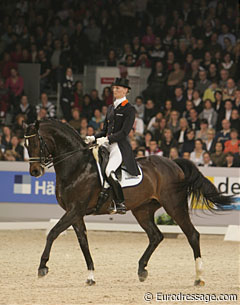 Third place went to Imke Schellekens-Bartels and the Smarius family's Hanoverian mare Sunrise (by Singular Joter). Schellekens entered the World Cup Finals with a wild card, but with her Grand Prix ride she proved to be an asset to the competition. After a wobbly non-halt, Schellekens started her ride with good extensions and lovely half passes in which the mare momentarily went a bit behind the vertical, but that was the only moment when she dropped a bit. Throughout the ride the contact with the bit was steady and nice and she stayed up in the frame till the end. The mare had no problems with the piaffe-passage, neither with the tempi changes which were nicely forward and ground covering. In the first pirouette she jumped a bit to the side but the second one was good. The general impression was that Sunrise is a delightful mare with good working hind legs, but they could step under more. The only disturbing factor in their performance was the constantly swooshing tail, which should be more relaxed and quiet. Their score: 73.458%
Third place went to Imke Schellekens-Bartels and the Smarius family's Hanoverian mare Sunrise (by Singular Joter). Schellekens entered the World Cup Finals with a wild card, but with her Grand Prix ride she proved to be an asset to the competition. After a wobbly non-halt, Schellekens started her ride with good extensions and lovely half passes in which the mare momentarily went a bit behind the vertical, but that was the only moment when she dropped a bit. Throughout the ride the contact with the bit was steady and nice and she stayed up in the frame till the end. The mare had no problems with the piaffe-passage, neither with the tempi changes which were nicely forward and ground covering. In the first pirouette she jumped a bit to the side but the second one was good. The general impression was that Sunrise is a delightful mare with good working hind legs, but they could step under more. The only disturbing factor in their performance was the constantly swooshing tail, which should be more relaxed and quiet. Their score: 73.458%
Landing fourth place were Finnish routinier Kyra Kyrklund and Yvette Conn's Swedish Warmblood Max (by Master). The absolutely highlights of this pair are the super soft contact with the bit and the absolutely relaxed impression Max gives while performing the Grand Prix moves. This general comfort translates in rhythmic piaffe and passage, outstanding extended walk and truly immobile halts. The horse sits beautifully in the piaffe but could kick off the ground more quickly. The tempi changes are his only weakness, they lack straightness in the body, and both pirouettes were executed a bit too big. They scored 72.041%
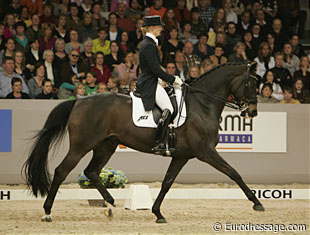 Very generously marked were Nathalie Zu Saeyn-Wittgensteinand her mother's Danish warmblood gelding Digby (by Donnerhall). The pair started their test with much tension and a very heavy contact with the bit. Digby did not look happy while performing a mediocre extended trot and tensed half passes. The normal looking Digby glamoured up in the piaffe and passage, though. Good impulsion and rhythm made Digby bounce off the ground, yet in the passage he moved unevenly, expressing himself in short and long steps with a more engaging right hind leg. The extended walk was very good. In the two-tempi's, Digby pushed his croupe a bit high, but the flying changes were straight and correct. The piaffe-passage on the centerline was very nice with lovely transitions, but again Digby had a too active right hind leg in the final stretch towards halt. They scored 70.666% and finished fifth.
Very generously marked were Nathalie Zu Saeyn-Wittgensteinand her mother's Danish warmblood gelding Digby (by Donnerhall). The pair started their test with much tension and a very heavy contact with the bit. Digby did not look happy while performing a mediocre extended trot and tensed half passes. The normal looking Digby glamoured up in the piaffe and passage, though. Good impulsion and rhythm made Digby bounce off the ground, yet in the passage he moved unevenly, expressing himself in short and long steps with a more engaging right hind leg. The extended walk was very good. In the two-tempi's, Digby pushed his croupe a bit high, but the flying changes were straight and correct. The piaffe-passage on the centerline was very nice with lovely transitions, but again Digby had a too active right hind leg in the final stretch towards halt. They scored 70.666% and finished fifth.
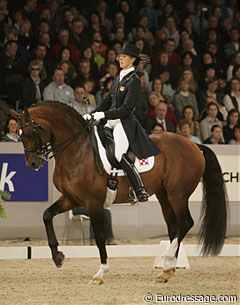 17-year old Swedish warmblood stallion Briar (by Magini) did his job like a professor under Jan Brink. Gorgeous half passes, lovely piaffes and passages, solid tempi changes, and small pirouettes. Briar produced the quality performance he's know to deliver at his peak. The hind legs do no track up enough in the extended trot and that's a sore in the eye of many judges and spectators. 70.500% and a 6th place was the end result.
17-year old Swedish warmblood stallion Briar (by Magini) did his job like a professor under Jan Brink. Gorgeous half passes, lovely piaffes and passages, solid tempi changes, and small pirouettes. Briar produced the quality performance he's know to deliver at his peak. The hind legs do no track up enough in the extended trot and that's a sore in the eye of many judges and spectators. 70.500% and a 6th place was the end result.
Best performing non-European rider was American Courtney King. This sympathetic 30-year old young rider has become one of America's best performers and will make her way into the U.S. Grand Prix Dressage Team soon. Aboard the 18-year old Idocus (by Equador), she excelled in the piaffe and passage, extended canter, and pirouettes. The tempi changes were textbook examples of how to perfectly spread the changes on the diagonal. The collected walk was not clear in rhythm, though, and leaned towards pacing. Idocus lost some power in the final passage, but overall, Courtney showed what a quality rider she is and had her stallion at peak performance. The judges ranked her seventh on 70.125%.
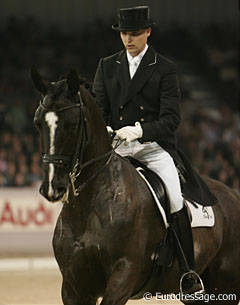 World Equestrian Games' favourite of the public, Andreas Helgstrand, rode the youngest horse of the show. The 9-year old Gredstedgards Casmir (by Continue) is a super talented horse, but just like Helgstrand's Blue Hors Matine, pushed too hard at an early age. One can wonder if Casmir is able to stay sound, because WEG medal winning Matine has proven not to be able to physically cope with the demands of top level dressage at her age (she was 8 at the WEG). The visual signs for this are the horse losing its balance in the more collected movements and the unsteady contact with the bit. Helgstrand is constantly visibly half halting in an attempt to keep the dark bay gelding soft in the mouth. The horse is asked to develop so much power in his hind legs but can not cope with it yet and, therefore, tries to take weight on the bit or makes uneven steps. This will be resolved in the future when Casmir learns to manage his power by being able to keep the same level of push during a whole Grand Prix ride. Now in the World Cup Grand Prix, Casmir showed his super star potential, but also his youthfulness. The half passes were too passagey, the tempi changes were not straight in the body and neither was the extended canter. The pirouettes were good though, as well as the extended walk. In piaffe and passage, Casmir shows incredibly push (just like Matine) but the passage is uneven with short and long steps. Nevertheless, Casmir is a horse to watch out for in the future! They scored 69.708% and finished 9th.
World Equestrian Games' favourite of the public, Andreas Helgstrand, rode the youngest horse of the show. The 9-year old Gredstedgards Casmir (by Continue) is a super talented horse, but just like Helgstrand's Blue Hors Matine, pushed too hard at an early age. One can wonder if Casmir is able to stay sound, because WEG medal winning Matine has proven not to be able to physically cope with the demands of top level dressage at her age (she was 8 at the WEG). The visual signs for this are the horse losing its balance in the more collected movements and the unsteady contact with the bit. Helgstrand is constantly visibly half halting in an attempt to keep the dark bay gelding soft in the mouth. The horse is asked to develop so much power in his hind legs but can not cope with it yet and, therefore, tries to take weight on the bit or makes uneven steps. This will be resolved in the future when Casmir learns to manage his power by being able to keep the same level of push during a whole Grand Prix ride. Now in the World Cup Grand Prix, Casmir showed his super star potential, but also his youthfulness. The half passes were too passagey, the tempi changes were not straight in the body and neither was the extended canter. The pirouettes were good though, as well as the extended walk. In piaffe and passage, Casmir shows incredibly push (just like Matine) but the passage is uneven with short and long steps. Nevertheless, Casmir is a horse to watch out for in the future! They scored 69.708% and finished 9th.
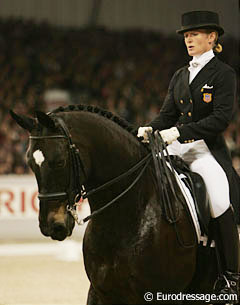 Another pair to keep an eye on are American newcomers Jane Hannigan and Maksymilian. The pair was on its way to a solid 70% score on their first international competition on European soil, but mistakes led to a 67.375% score. Hannigan, who took out an equity loan to pay for her horse and the trip to Europe, presented her black gelding with much style. Mak (by Elcaro) has three outstanding basic gaits and is super talented. His piaffe and passage are delightful but Mak still loses balance. A mistake in the one tempi's and first pirouette were the killing factors for total glory in the Grand Prix. They finished 13th.
Another pair to keep an eye on are American newcomers Jane Hannigan and Maksymilian. The pair was on its way to a solid 70% score on their first international competition on European soil, but mistakes led to a 67.375% score. Hannigan, who took out an equity loan to pay for her horse and the trip to Europe, presented her black gelding with much style. Mak (by Elcaro) has three outstanding basic gaits and is super talented. His piaffe and passage are delightful but Mak still loses balance. A mistake in the one tempi's and first pirouette were the killing factors for total glory in the Grand Prix. They finished 13th.
Photos copyrighted: Astrid Appels/Eurodressage
Back to the 2008 World Cup Index